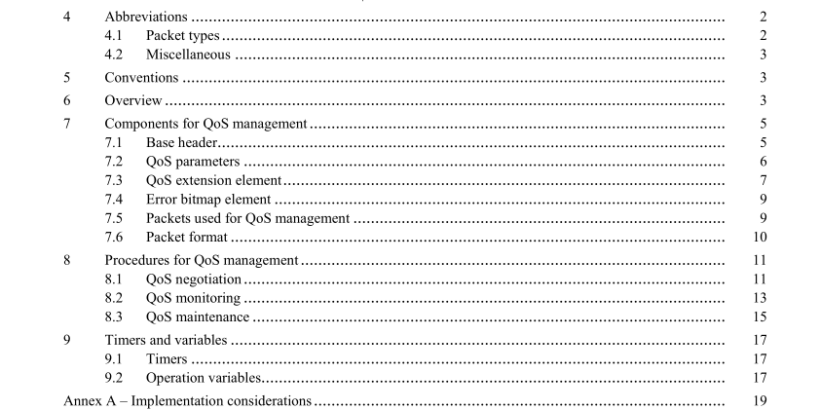ISO IEC 14476-6:2010 pdf download – Information technology — Enhanced communications transport protocol: Specification of QoS management for n-plex multicast transport
8 Procedures for QoS management
In ECTP-6, QoS management includes the following operations:
a) QoS negotiation, possibly with reservation of network resources;
b) QoS monitoring;
c) QoS maintenance.
QoS negotiation is performed in the connection creation phase, while QoS monitoring and maintenance operations are done in the data transmission phase. If QoS management is enabled in the connection, QoS monitoring and maintenance operations are performed by default. On the other hand, QoS negotiation is enabled only when the N bit in the ‘QN’ byte of the ECTP-5 base header is set to ‘1’.
8.1 QoS negotiation
The TCN transmits a CR packet to all TS-users to start the connection creation phase. The CR packet contains the proposed (or imposed) target values for each QoS parameter such as CHQ, OT and LQA for the multicast data channel. Each TS-user can refer to these target values for resource reservation (see 8.1.3). If QoS negotiation is enabled in the connection, the negotiation procedures are activated (see 8.1.1). The imposed or negotiated target values are subsequently used in QoS monitoring and maintenance (see 8.2 and 8.3). If QoS negotiation is enabled in the connection, each TS-user can propose a new modified value for the multicast data channel to send and receive multicast data in response to a target parameter value proposed by the TCN. To propose a new value, a TS-user is required to be able to identify the system or network resources to be used. For example, a modified throughput value may be assessed from line rates of transmission links accessible at the TS-user site (e.g., DSL, cable modem, wireless networks, and so on).
The modified value may also be determined by considering the end user’s requirement for receiving and sending multicast data at a TS-user site. It is possible for an end host to use a software program to determine the modified parameter value for negotiation, based on network and system resources, as well as end user’s requirements. However, in real world scenarios, it is not easy to precisely identify the resource capacity of the networks involved with a receiver. Accordingly, at least in the near future, QoS negotiation will be done based on the end user’s requirements at the application level or on the system capacity of the end host. In this Specification, a TCN is required to specify via the QoS extension element whether each QoS parameter is subject to negotiation (see 7.3). For parameters that are negotiable, a TS-user can propose modified values. If a TS-user does not wish to modify a QoS parameter, it will just return the same QoS element received from the TCN.
8.1.1 Negotiation procedures If QoS negotiation is enabled in the connection, each TS-user responds to the TCN with a CC packet containing the modified target values for the respective QoS parameters. This clause describes the QoS negotiation procedures for the throughput parameter, which has three target values: LQA, OT and CHQ. The negotiation procedures for the other parameters such as delay, jitter and loss rate are all the same except that these parameters have no CHQ values.
During QoS negotiation, TS-users must not modify the OT value for each parameter. The detailed procedures for QoS negotiation are described below and illustrated in Figure 6.
a) The TCN proposes target parameter values for the multicast data channel to send and receive multicast data From application requirements and system and/or network capacity, the TCN determines the target parameter values for multicast data: LQAo, OTo, CHQo, where LQAo < OTo < CHQo, and then transmits a CR packet with two QoS extension elements for sending multicast data to TS-users and receiving multicast data from TS-users.
b) TS-users can modify the parameter values for the multicast data channel sending and receiving multicast data In response to the target values proposed by the TCN, each TS-user i can propose the modified values for sending and receiving multicast data: LQA i and CHQ i . OTo value must not be changed. Thus, the following inequalities are enforced: LQAo < LQA i < OTo < CHQ i < CHQo for each TS-user i. Each TS-user delivers the modified values to the TCN via a CC packet with two QoS extension elements for sending and receiving multicast data.ISO IEC 14476-6 pdf download.
